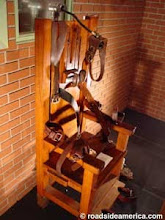Many people saw that these executions were direct offense of the inmates rights. This eighth amendment states that, Excessive bail shall not be required, nor excessive fines imposed, nor cruel and unusual punishments inflicted. Many thought that killing someone by strapping them to a chair and sending jolts of electricity through their bodies until they were pronounced dead were definitely cruel and unusual punishment. Others felt the same way, but saw it fit for these inmates who had been sentenced to death to be executed still. So then there was a stand still at what other method could be used in order to execute these men and women in a more humane way. In the year 1972 there was a ruling on a supreme court case named Furman v. Georgia, where the US Supreme Court declared capital
punishment unconstitutional.[10] The case was decided by a five to four vote on split opinions and many of the Justices in favor of abolishing the death penalty voiced their opinions publically. As of June 29th, 1972 there were forty-five men on death row and seven others in county jails awaiting their death sentence. All of these men’s lives were spared by the Governor and their sentences were changed from death sentences to life sentences. Justices Brennan and Marshall both saw that executions were, under any circumstances, cruel and unusual punishment, and with that opinion felt that they were in direct violation of the eighth amendment stated earlier. Another opinion voiced by Justice White saw that the Death Penalty had a legal place in the nation if it had some kind of pattern or what used more frequently. He thought that if it was used more often and was a definite sentence to fit a certain amount of crimes, instead of some convicts receiving death row sentences and some receiving lifetime sentences. So because there wasn’t a direct pattern of death sentences being issued he saw that there must have been some other issues that made the juries give it to some but not all.[11] This opinion was quickly addressed by the sate of Texas in 1973 where the state passed House Bill 200, which became effective on June 14, 1973. So once the Supreme Court made their decision that capital punishment was ‘cruel and unusual” punishment the State of Texas made a new statute that would standardize the way to asses the death penalty, instead of the sentences that we handed down to some but not all, which was what Justice White’s argument was all about.[12] It said that offenders who knowingly and intentionally committed a list of five crimes would be subject to capital punishment.[13] The first of these reasons was the killing of a peace officer or fireman who was in uniform and the defendant knew was a peace officer or fireman. The second was that if the defendant committed murder in the course of any of the following: kidnapping, burglary, robbery, forcible rape, or arson. Third case, if the person committed a murder for remuneration purposes or had someone else kill for remunerations. Fourth of these circumstances was if someone committed a murder while attempting to escape from a penal institution. And lastly was if the person was incarcerated in a penal institution and murdered someone who was employed by the prison system.[14] And after twelve years another circumstance was added to the list of crimes deemed worthy of the death penalty. Added in 1985 the final statute read, if the person murders more than one person at the same time, or more than one person with the same criminal scheme involved.[15] In 1974 it was seen fit that executions could resume but under a new method. On August 29th, 1977 the state of Texas adopted their new method of execution, Lethal Injection.[16]
[10,11] Marquart, Ekland-Olsen, Sorensen,The Rope, The Chair, and The Needle: Capital Punishment in Texas, 1923-1990. 1st ed. Austin, TX: University of Texas Press, 1994
[12] Byrd, , Robbie, and Jessica Hamilton. "History in the making." Huntsville Item Aug. 2007, Print.
[13,14,15] Marquart, Ekland-Olsen, Sorensen,The Rope, The Chair, and The Needle: Capital Punishment in Texas, 1923-1990. 1st ed. Austin, TX: University of Texas Press, 1994
[16] "Texas Execution Procedures and History." http://www.mindfully.org/Reform/Texas-Execution- Procedures-History.htm (accessed November 17, 2009).

